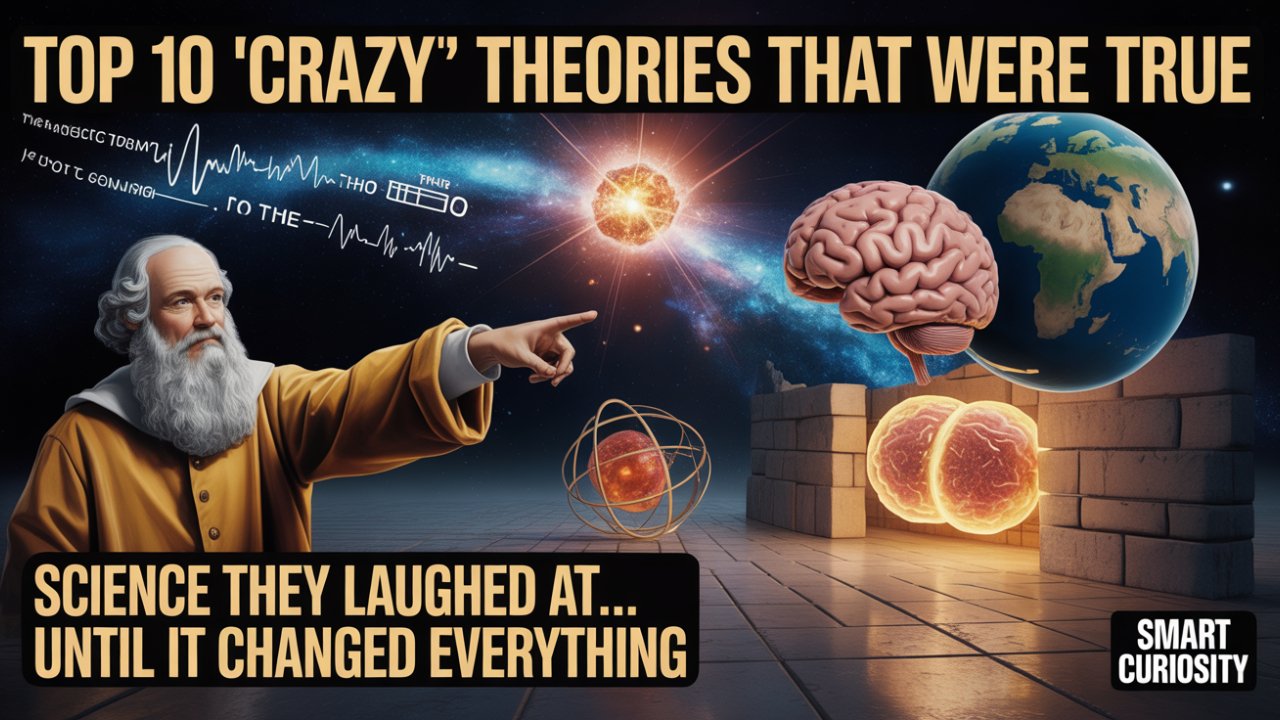What if I told you that some of history’s most brilliant minds were once called heretics, fools, and crackpots? Today, we’re counting down 10 scientific theories that were so out there, they were literally laughed out of the room right before they changed the world forever.
Science is a story of progress, but it’s rarely a straight line. It’s a messy, human journey, full of brilliant insights, stubborn beliefs, and ideas so radical they sound like something from a sci-fi novel. The theories on our list today weren’t just small tweaks; they were earthquakes that shattered the very foundations of reality as we knew it. They’re a testament to the power of curiosity, the guts to question everything, and the relentless search for truth, no matter how absurd it might seem. From the wiring of our own brains to the very fabric of the cosmos, get ready to have your mind blown by the heretics who turned out to be prophets.
Number 10: Adult Neurogenesis
Let’s kick off our list with a belief that was carved into the stone tablets of neuroscience for nearly a century: once you’re an adult, your brain stops making new neurons. The brain cells you had were all you were ever going to get. The idea that you could grow new ones was considered not just wrong, but biologically impossible. The brain, everyone was taught, was a fixed, static organ. After you grew up, it was all downhill a slow, inevitable loss of cells. This belief was so deeply entrenched that challenging it was basically career suicide.
The opposition to this idea wasn’t some shadowy villain; it was personified by powerful figures like neuroscientist Pasko Rakic. In the 1980s, his influential studies on primates seemed to hammer the final nail in the coffin, confirming the no new neurons rule. His work was meticulous, his reputation was formidable, and for decades, his conclusions were treated as the final word. The consensus was clear: sure, rats and birds might grow new brain cells, but not complex primates like us. For years, anyone who suggested otherwise was often dismissed, marginalized, or even attacked.
But the first cracks in this dogma had actually appeared way earlier. Back in the 1960s, a scientist named Joseph Altman published data showing evidence of new neurons forming in the brains of adult rats. He was almost completely ignored. His work was brushed off as an anomaly, probably an error. For decades, his findings were just a footnote in a field that had already made up its mind. It wasn’t until the 1990s, with new technology and a growing acceptance of the brain’s plasticity, that the idea got a second look.
The final breakthrough has been a slow burn over the last two decades. Using advanced techniques like RNA sequencing, researchers could finally spot the unique molecular signature of brand-new, baby neurons. In a landmark 2018 study, and in subsequent research, scientists examined post-mortem brain tissue from people of all ages. What they found was revolutionary: clear evidence of thousands of new neurons in the hippocampus a key area for memory even in the brains of 78-year-olds. While there is still some debate about how much this process slows in old age, the discovery has shattered the old dogma. It’s now widely accepted that adult neurogenesis is real, opening up incredible new avenues for treating conditions like Alzheimer’s and depression. It turns out the brain isn’t a static relic; it’s a dynamic, living organ, capable of growth we once dismissed as absurd.
Number 9: Time Crystals
Imagine a diamond. Its atoms are locked into a repeating pattern in space that’s a crystal. Now, try to imagine an object whose atoms repeat their pattern not just in space, but in time. An object that moves in a regular, repeating loop, forever, without any energy being put into it. It sounds exactly like a perpetual motion machine, a blatant violation of the most basic laws of physics. So when Nobel Prize-winning physicist Frank Wilczek first proposed time crystals in 2012, you can bet the physics community was more than a little skeptical. It just seemed impossible.
The heart of the ridicule was aimed at the core concept. A fundamental law of physics, the second law of thermodynamics, says that systems tend to drift towards disorder. An object in its lowest energy state, its ground state, should be perfectly still. The idea of a ground-state object with built-in, perpetual motion seemed like a physical contradiction. How could something be at its lowest possible energy and still be moving? It was like saying a ball could be sitting at the bottom of a valley, yet somehow be rolling back and forth forever. Many physicists dismissed it as a mathematical quirk that could never exist in the real world.
The path from theory to reality was a wild one. Other theorists refined Wilczek’s idea, realizing that while a perfect time crystal might be impossible, a driven one wasn’t. This version wouldn’t be a closed-system perpetual motion machine. Instead, it would be a bizarre new state of matter that exists when you push it with an external force, like a laser. Here’s the truly weird part: the time crystal would oscillate at a different rhythm than the push it was receiving. Imagine pushing a kid on a swing once every three seconds, but they only swing back and forth once every six seconds. That strange, subharmonic response is what scientists started hunting for.
And in 2016, they found it. In two separate, groundbreaking experiments, teams at the University of Maryland and Harvard announced they had built time crystals. Using chains of trapped ions and zapping them with precise laser pulses, they created systems that started oscillating at a fraction of the laser’s frequency. The pattern was stable, robust, and held its rhythm even when the laser pulses were a little off. They had created a new phase of matter, one that breaks time-translation symmetry. It was no longer a fantasy. The discovery is so new that we’re still figuring out what it all means, but some of the potential applications sound like pure sci-fi. The hope is they could lead to ultra-stable quantum computer memory or incredibly precise clocks, but for now, they remain a stunning example of an impossible object made real.
Number 8: The Heat Death of the Universe
Of all the predictions in science, this one is maybe the most terrifying. The theory of the Heat Death of the Universe suggests that the cosmos has a limited supply of usable energy. And one day, an almost unimaginably long time from now, it will all run out. The universe will settle into a state of maximum entropy, where all energy is spread perfectly even. There will be no heat, no light, no movement, no life. Just a cold, dark, and perfectly uniform emptiness, forever.
When this idea first popped up in the 1850s from the work of physicists like Lord Kelvin, it was met with philosophical horror. The popular view at the time was of an eternal, maybe even cyclical, universe. The thought that the entire cosmos could just run down and die felt deeply unsettling. It was seen as a bleak, overly dramatic take on the new laws of thermodynamics. The argument against it was pretty simple: the universe clearly isn’t dead yet, so if it’s been around forever, it should have already reached this state. Therefore, the theory must be wrong.
But that very argument became the key to its acceptance. The heat death paradox was turned on its head to argue against an infinitely old universe. If the universe must eventually run down, and it hasn’t, then it can’t have existed forever. It must have had a beginning. And that line of thinking fit perfectly with another, equally absurd-sounding idea that was gaining traction in the 20th century: the Big Bang.
The vindication of the Heat Death theory is tied directly to our modern understanding of the cosmos. The discovery that the universe isn’t just expanding, but that the expansion is accelerating because of dark energy, provides the very mechanism for this ultimate fate. Our best cosmological models overwhelmingly point to a future where the universe expands forever. As it expands, it gets colder. The timeline is just staggering. In trillions of years, all the gas needed to form new stars will be gone. The existing stars will burn out, leaving behind black dwarfs and black holes. Over googols of years, even matter itself might decay. Finally, the supermassive black holes will evaporate through Hawking radiation. The universe will be left as a dilute, frigid sea of particles approaching absolute zero, with no temperature differences left to drive any action at all. This Big Freeze, or Heat Death, is now considered the most likely fate of our universe a chillingly profound concept that started as an unwelcome, absurd idea.
Number 7: Quantum Tunneling
Imagine throwing a tennis ball at a solid brick wall. Every law of physics you know says the ball will bounce off. It simply doesn’t have the energy to break through. Now, imagine that ball is a subatomic particle, like an electron, and the wall is an energy barrier. Quantum mechanics predicts that there is a small, but real, probability that the electron will just appear on the other side, without ever having the energy to go over the barrier. It effectively tunnels through a place that should be totally impenetrable.
When this idea emerged from the bizarre new math of quantum theory in the 1920s, it seemed like a mathematical ghost, a nonsensical glitch in the equations. To physicists raised on the concrete, predictable laws of classical mechanics, tunneling was just plain absurd. The notion that a particle could be in a place it was forbidden to be by the law of energy conservation seemed to violate common sense. It was as if the tennis ball could literally teleport through the wall. Early pioneers who applied the concept, like George Gamow, faced a scientific establishment that was deeply uncomfortable with the weird, probabilistic nature of the quantum world.
The first major proof for this bizarre theory came from inside the atom itself. For years, scientists couldn’t explain a mystery called alpha decay, where heavy atomic nuclei, like uranium, spontaneously spit out a particle. According to classical physics, the forces holding the nucleus together were like an impossibly high wall; those particles should have been trapped forever. But in 1928, Gamow used quantum tunneling to explain it. He showed that the particle wasn’t going over the barrier; it was tunneling through it. His calculations perfectly predicted the observed half-lives of radioactive elements. It was a stunning success.
Today, quantum tunneling isn’t just a weird theory; it’s a fundamental process that makes our world work. It’s the reason our Sun shines. The temperatures in the Sun’s core are actually too low for protons to classically overcome their repulsion and fuse. Instead, they get close, and then they tunnel through that final energy barrier to fuse, releasing the immense energy that lights up our solar system. Without tunneling, there’d be no nuclear fusion in stars. The universe would be dark and lifeless. It’s also at the heart of modern electronics, essential for things like the flash memory in your smartphone, and it’s the principle behind Scanning Tunneling Microscopes, which let us see individual atoms. The theory once dismissed as a phantom is now one of the most critical and verified phenomena in all of physics.
Number 6: Continental Drift
Take a look at a world map. Notice how the east coast of South America seems to snuggle perfectly into the west coast of Africa? For centuries, people saw this jigsaw-puzzle fit, but wrote it off as a funny coincidence. Then, in 1912, a German meteorologist named Alfred Wegener came along and proposed something crazy: it wasn’t a coincidence at all. He argued that the continents weren’t fixed, but were slowly drifting across the Earth, and had once been joined together in a single supercontinent he called Pangaea.
The reaction from geologists was swift and brutal. Wegener was openly mocked, his theory dismissed as geopoetry. He was a meteorologist, an outsider who had no business meddling in their field. The establishment view was of a solid, rigid Earth with permanent continents and oceans. The idea that colossal landmasses could somehow plow through the solid rock of the seafloor was seen as physically impossible. What force, they scoffed, could possibly move an entire continent? Wegener couldn’t provide a good answer for the engine driving it all, and for that, his entire theory was tossed in the garbage.
But Wegener wasn’t just looking at shapes on a map. He gathered a mountain of evidence. He pointed out that fossils of the exact same land animals and plants were found on continents now separated by thousands of miles of ocean. How did they get there? He showed that unique rock formations and mountain ranges on different continents lined up perfectly if you pushed them back together. He even presented evidence of ancient glaciers in places like India and Africa, suggesting they were once located near the South Pole. Despite all this, the opposition wouldn’t budge for decades. Without a mechanism, it was all just circumstantial evidence. Wegener died on an expedition in 1930, his theory still considered scientific nonsense.
Vindication finally came, but it took a world war and new technology. During WWII, a geologist and Navy submarine commander named Harry Hess was using new sonar technology to map the ocean floor. What he found was incredible: a massive, underwater mountain range snaking around the globe, which we now call the Mid-Atlantic Ridge. Years later, in 1962, Hess proposed the missing mechanism: seafloor spreading. He realized that molten rock was bubbling up at these ridges, creating new ocean floor, and pushing the continents apart like giant conveyor belts. Later studies of magnetic stripes on the ocean floor confirmed it, providing a perfect record of the Earth’s magnetic field reversing over millions of years. This was the smoking gun. Wegener’s absurd idea was reborn as the theory of plate tectonics, which is now the absolute foundation of modern geology. The heretic meteorologist was finally proven right.
If you’re finding this trip through science history as mind-bending as we are, do us a favor and hit that subscribe button and ring the notification bell. We explore the most fascinating stories from science and the universe every week, and you won’t want to miss what’s coming up next. Now, back to the countdown.
Number 5: Germ Theory of Disease
For most of human history, getting sick was a terrifying mystery. Plagues and infections were blamed on everything from an imbalance of humors in the body to divine punishment or, most popular of all, miasma basically, bad air or foul smells from decaying stuff. The idea that tiny, invisible living things germs could invade our bodies and kill us was considered ridiculous.
The pioneers of germ theory faced vicious, personal ridicule. Just look at the tragic story of Ignaz Semmelweis, a doctor in 1840s Vienna. He noticed that women in the maternity ward attended by doctors, who came straight from doing autopsies, were dying of childbed fever at a shocking rate. He guessed that cadaverous particles were being carried on the doctors’ hands. He made hand-washing with a chlorine solution mandatory, and the death rate plummeted. His reward? He was mocked and driven out of the medical community. The suggestion that a gentleman doctor’s hands could be dirty was a deep insult. He died in a mental asylum, his discovery all but forgotten.
Decades later, Louis Pasteur in France faced similar scorn when he proposed that microorganisms were souring wine and causing disease. Established scientists clung to the idea of spontaneous generation, the belief that life could just magically spring from non-living matter, like maggots from meat. Pasteur’s ideas were an attack on cherished beliefs.
The proof came from the microscope. While microbes had been seen centuries earlier, they were considered little curiosities. It was the painstaking work of Pasteur and his contemporary Robert Koch that sealed the deal. Pasteur’s famous swan-neck flask experiments disproved spontaneous generation for good. Koch took it a step further by developing a rigorous method to link a specific microbe to a specific disease. He identified the bacteria for anthrax, tuberculosis, and cholera, proving beyond all doubt that these invisible organisms were the real killers.
The acceptance of germ theory is arguably the single most important revolution in medical history. It changed everything about how we live and die. It led directly to antiseptics, which transformed surgery from a death sentence into a life-saving procedure. It gave us vaccines, sanitation systems, and public health policies that have doubled human life expectancy in just over a century. The once-absurd notion of invisible killer creatures is now the foundation of all modern medicine.
Number 4: The Expanding Universe & The Big Bang
Picture the universe as it was understood in the early 20th century: static, eternal, and unchanging. This was the view held by almost everyone, including Albert Einstein. In fact, his own theory of General Relativity predicted a dynamic universe one that should be expanding or contracting. This bothered him so much that he saw it as a flaw and added a fudge factor, the cosmological constant, just to force his model of the universe to hold still.
Into this static cosmos stepped Georges Lemaître, a Belgian priest and physicist. In 1927, using Einstein’s own equations without the fudge factor, Lemaître proposed something nuts: the universe was expanding. He then reasoned backwards: if it’s expanding now, it must have been smaller in the past. He traced it all the way back to a single point in time and space, a cosmic egg that exploded at the moment of creation. The scientific community, including Einstein, pretty much ignored him. Einstein reportedly told Lemaître, Your calculations are correct, but your physics is abominable. The idea of a beginning sounded too much like religion, not science. The theory was so mocked that its famous name, the Big Bang, was actually coined as an insult by astronomer Fred Hoyle, who found the idea foolish.
The first piece of hard evidence came just two years later from American astronomer Edwin Hubble. He was observing distant galaxies and noticed their light was shifted towards the red end of the spectrum, or redshifted. This is the cosmic version of the Doppler effect. It meant the galaxies were all moving away from us. And the farther away a galaxy was, the faster it was moving. This was the proof: Lemaître’s expanding universe was real.
The final, undeniable proof came in 1965, completely by accident. Two astronomers at Bell Labs, Arno Penzias and Robert Wilson, were trying to get rid of an annoying hiss in their radio antenna. No matter where they pointed it, this faint, uniform noise was there. They even cleaned out pigeon droppings from the antenna, thinking that might be it. It wasn’t. What they had accidentally found was the afterglow of creation itself: the Cosmic Microwave Background radiation. This was the faint echo of heat left over from the Big Bang, exactly as the theory predicted. It was the ultimate smoking gun. The absurd theory became the standard model of cosmology, and Einstein later called his fudge factor his biggest blunder. Lemaître’s abominable physics turned out to be the story of our universe.
Number 3: Theory of Evolution by Natural Selection
In the mid-19th century, the world was a place of certainty. Every plant and animal was seen as a fixed, unchanging creation, made perfectly for its purpose by a divine hand. Humans were special, completely separate from the animal kingdom. Then, in 1859, a quiet English naturalist named Charles Darwin published On the Origin of Species, and that certainty was shattered. His theory was profound: species weren’t fixed. They changed over eons, evolving from common ancestors through a process he called natural selection.
The reaction was immediate and volcanic. Darwin’s theory was met with outrage. Religious leaders called it heresy. But many top scientists also attacked it. The great physicist Lord Kelvin argued that the Earth was far too young for a slow process like evolution to work. And the idea that humans were descended from ape-like ancestors was seen as a deep insult to human dignity, famously mocked in cartoons showing Darwin’s head on a monkey’s body. The theory was seen as a dangerous idea that would degrade humanity.
Darwin’s path to this explosive theory was a long and patient one, starting with his five-year voyage on the HMS Beagle. He spent the next twenty years back home, gathering a mountain of evidence from animal breeding, anatomy, and the fossil record. The mechanism he proposed, natural selection, was brutally simple: more organisms are born than can survive. They all have tiny variations. The ones with variations best suited to their environment are more likely to survive, reproduce, and pass on those winning traits. Over vast stretches of time, this process could create entirely new species.
The vindication of Darwin’s theory has been so absolute that it’s now the unifying principle of all biology. The discovery of genetics provided the mechanism for inheritance that Darwin never knew. The Modern Synthesis merged Darwin’s selection with genetics into the robust framework we have today. Paleontologists have found stunning transitional fossils, showing whales evolving from land mammals and birds from dinosaurs. And most powerfully, the discovery of DNA has delivered the ultimate proof. We can now literally read the genetic code and see the tree of life that Darwin first sketched in his notebook. Evolution by natural selection, an idea once hated as heretical, is now the core concept that makes sense of all life on Earth.
Number 2: Heliocentrism
For about 1,500 years, humanity’s view of the universe was simple, intuitive, and dead wrong. The Earth was the stable, unmoving center of everything. The Sun, Moon, and planets all revolved around us in perfect spheres. This geocentric model, perfected by the astronomer Ptolemy, wasn’t just science; it was woven into philosophy, religion, and pure common sense. After all, you could see the Sun move across the sky, and the ground felt perfectly still. To suggest otherwise was crazy it contradicted both scripture and the evidence of your own senses.
The man who challenged this ancient dogma was a Polish astronomer named Nicolaus Copernicus. He proposed a radical alternative: the Sun, not the Earth, was the center of it all. The Earth was just another planet, spinning on its axis once a day and orbiting the Sun once a year. Copernicus was so terrified of the backlash he’d get from the Church and other academics that he waited until he was on his deathbed in 1543 to publish his work. His fears were justified. Protestant reformer Martin Luther called him a fool. Decades later, when the Italian astronomer Galileo Galilei championed the Copernican system, the opposition became ferocious. The Catholic Church declared heliocentrism a heresy. Galileo was put on trial, forced to recant, and sentenced to house arrest for the rest of his life.
The path to vindication was fought with a new weapon: the telescope. When Galileo pointed his to the sky, he saw things that were impossible in the old model. He saw that the Moon wasn’t a perfect orb, but was covered in mountains and craters, like Earth. He discovered four moons orbiting Jupiter, proving not everything circled us. And the killer blow: he saw that Venus went through a full set of phases, just like our Moon. This could only happen if Venus orbited the Sun inside of Earth’s orbit. Later, Johannes Kepler refined the model, showing that the planets moved in ellipses, not perfect circles, which made the math work beautifully.
The acceptance of heliocentrism was a cornerstone of the Scientific Revolution. It was more than a new star chart; it was a demotion for humanity. We were no longer the center of everything, just residents of a small planet in a vast cosmos. Isaac Newton’s laws of gravity finally explained why the planets moved this way, cementing the heliocentric model as fact. The theory that was once so blasphemous that its champion was imprisoned is now the first thing we teach kids about the solar system.
Number 1: Braneworld Theory
And here we are at number one. This is a theory so strange, so deeply counter-intuitive, it makes everything else on this list look like common sense. It comes from the cutting edge of theoretical physics, and it suggests that our entire universe everything you can see, every star, every galaxy is nothing more than a membrane, or brane, floating in a higher-dimensional reality called the bulk. No, that’s not a metaphor. Braneworld theory proposes there are extra spatial dimensions our senses can’t perceive. And while most particles and forces are stuck to our brane, the force of gravity can leak out into those extra dimensions.
First proposed in the late 1990s by physicists like Lisa Randall and Raman Sundrum, many saw the idea as mathematical science fiction. For decades, physicists had been stumped by the hierarchy problem: why is gravity so incredibly weak compared to other forces, like magnetism? This theory offered a wild explanation. To many, invoking unseeable, untestable dimensions to solve a theoretical problem seemed like a step too far. It was a brilliant, mathematically beautiful idea, but it sounded fundamentally, absurdly speculative.
The reason this theory is taken so seriously isn’t because of a single eureka! moment, but because of its power to solve that deep, nagging problem. In the braneworld model, gravity isn’t actually weak. It’s just as strong as the other forces, but its influence gets diluted because it spreads out into the higher-dimensional bulk, while we, and everything else, are stuck on our 3D brane. Think of it like shouting in a small room versus shouting in a huge, open field. Your voice is just as loud, but it seems much weaker in the open space. This provided a stunningly new way to think about one of the biggest puzzles in physics.
So, has it been proven? The answer is a clear not yet, but with a huge asterisk. Unlike a lot of speculative ideas, braneworld theory makes predictions we can actually test. For example, if gravity can leak out, giant particle colliders like the LHC might be able to spot energy that seems to just vanish from our brane into the bulk. So far, they haven’t found anything like that, but the search is on. While direct proof is still missing, the theory has become a highly influential and compelling part of modern physics because of its explanatory power. It asks a profound question: Is our universe just one slice of a much larger, higher-dimensional reality? Are there other branes out there, parallel universes floating next to our own? We don’t know. But the fact that this once-fantastical idea is now a serious part of our quest to understand reality makes it the perfect, mind-bending example of a theory that seemed absurd, but might just turn out to be true.
From the cells in our brains to the very edge of reality, the history of science is a graveyard of things we used to be sure about. The journey we’ve taken today shows one thing clearly: the most revolutionary truths often start out as the most ridiculed ideas. These ten theories, and the stubborn, brilliant people who fought for them, remind us that the most important tool in science is the courage to question what we think we know. They faced mockery and rejection, yet their ideas won, becoming the very foundation of our modern world.
What do you think? Which of these theories blew your mind the most? Is there a crazy-sounding idea in science today that you think might be proven true? Let us know down in the comments. We love reading your thoughts.
Thanks for joining us on this trip through the stranger side of science. If you enjoyed it, don’t forget to like, share, and subscribe for more deep dives into the mysteries of our universe. Until next time, keep questioning.





